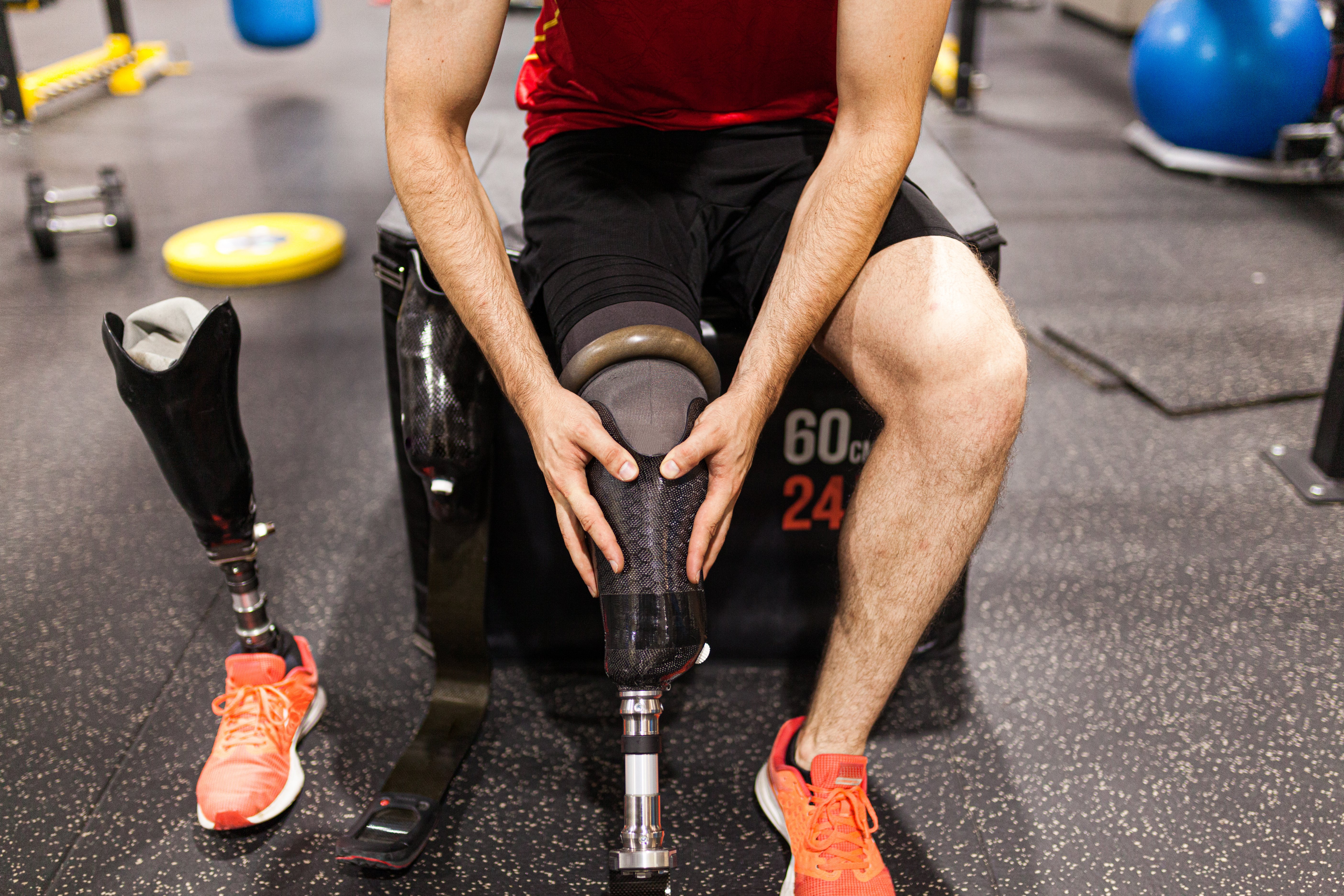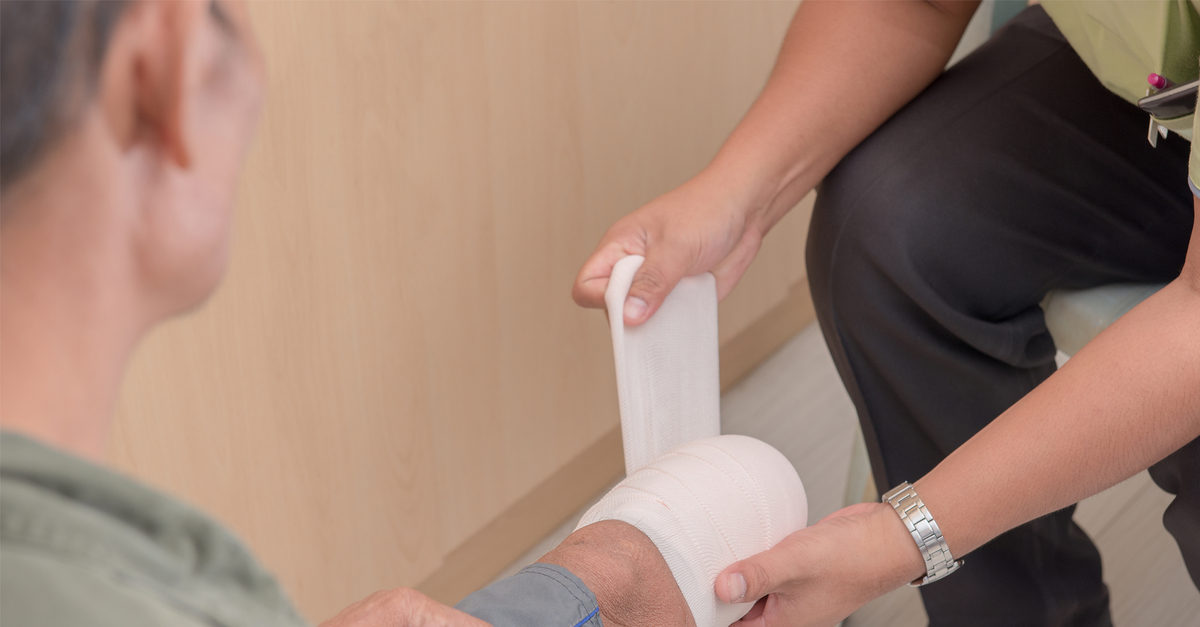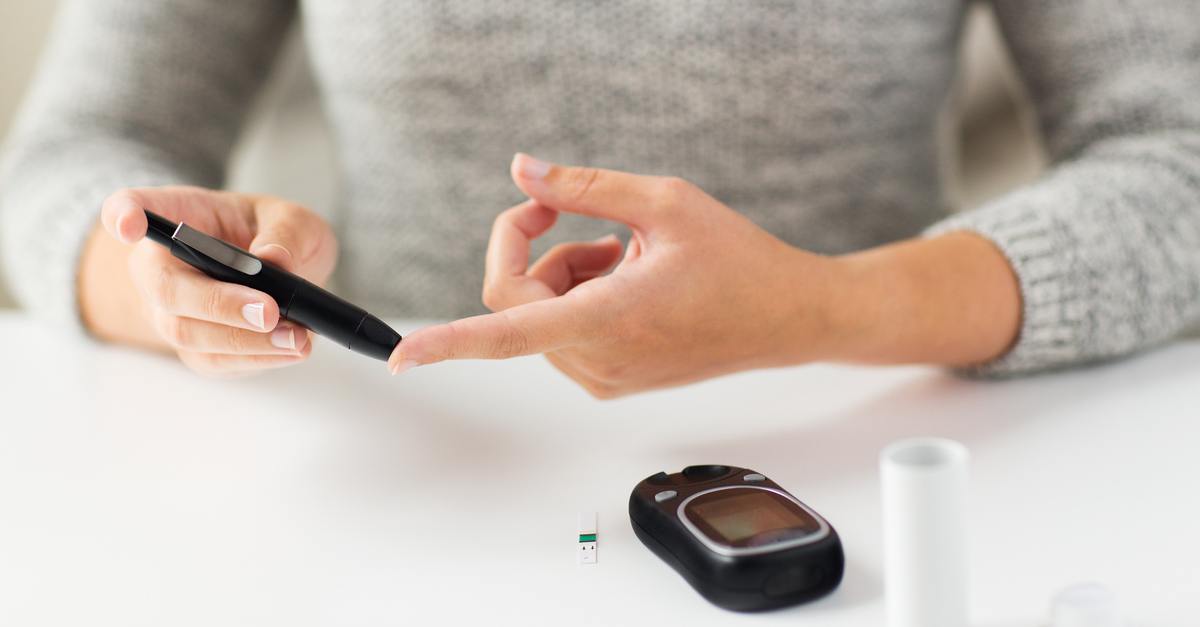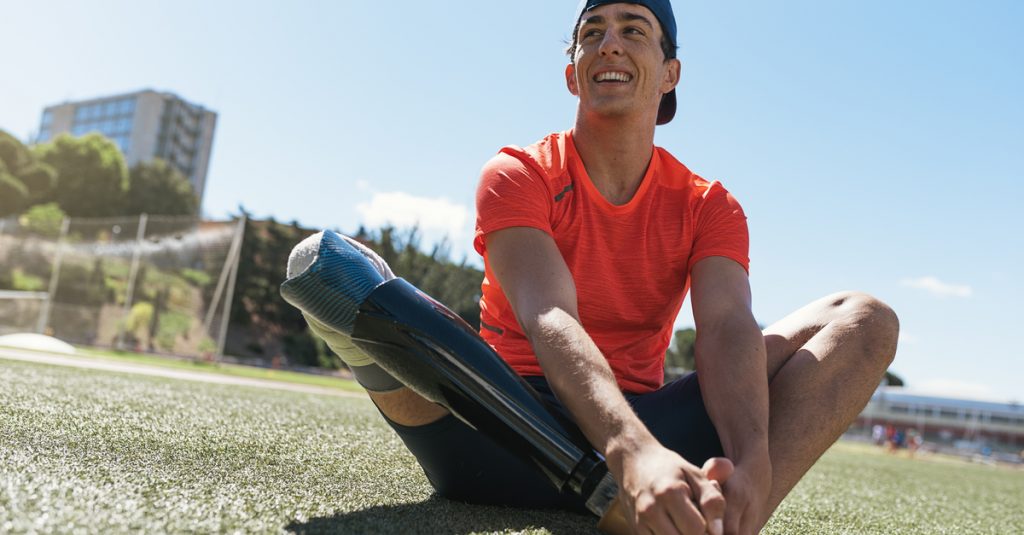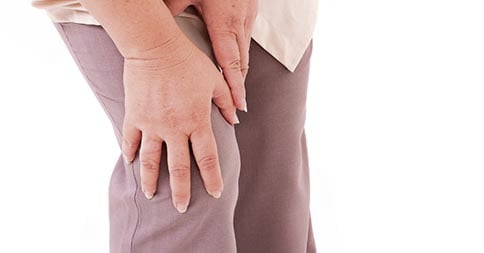When facing limb loss, the focus is often on physical changes and preparations—but the emotional changes post amputation can be equally challenging. It’s normal, healthy in fact, to grieve loss, especially one as significant as limb loss. With over one third of amputees reporting signs of clinical depression, it’s important to recognize emotional pain and how to treat it. Keep reading for five strategies to help you process limb loss.
#1: Community Support
Whether your limb loss is a result of trauma or a personal choice, it’s common to feel alone in the struggles that follow. This is why it’s critical to find a community to offer emotional support as you heal. There are nearly two million Americans living with limb loss who can share stories, listen to fears and frustrations, and offer encouragement and hope. Often, it’s enough to simply know that you are not alone in your struggles. There are others out there who can relate to your experience. Grief is normal, and grieving in community creates lasting bonds and a support system for years to come.
#2: Pay Attention to Your Feelings
There is no right way to feel following an amputation. Many focus on maintaining a positive outlook, while others struggle with anger. Some experience a rollercoaster of emotions on a daily basis. However you cope with change, the first step in dealing with loss is to recognize what you are feeling and tell yourself that it is okay to feel that way.
A life-changing event like limb loss brings about complex emotions. Don’t feel pressured to feel a certain way. Emotions may seem overwhelming at first but, over time, they will lose intensity as you process, especially in the context of a support group.
#3: Express Yourself
Finding a method of self-expression is important to your emotional well-being. Talk to a loved one or a professional counselor about your frustrations. It’s important to vent negative emotions.
Many find that keeping a journal, making art, and listening to music are helpful ways to express emotion.
#4: Stay in the Moment
It’s the journey, not the destination, that matters. When recovering from limb loss, rehabilitation may feel like an impossibility. Rather than focussing on an end goal, consider where you are today versus a week ago. When you look at where you are compared to where you want to be, it’s easy to get discouraged. Stay present and celebrate your progress.
#5: You Matter
One of the most helpful steps in rehabilitation is to find something that gives you purpose—a way to feel useful. Some look toward the spiritual for meaning or an explanation behind their limb loss. Others may be compelled to advocate for amputees or bring awareness to other causes. Finding a place to contribute will boost your confidence and self-esteem, driving your recovery and improving your quality of life.
Recovery post amputation involves more than just the physical. The complex emotions that come with grieving are normal and healthy. A good emotional support system is just as important as your physical support systems. Pay attention to how you feel day to day and talk to your physician if you have concerns about clinical depression.
For more expert advice on how to process limb loss, contact BioTech today.
Are you facing a transfemoral (above knee) amputation? This is a surgical procedure to remove the lower limb at or above the knee joint when that limb has been severely damaged via trauma, disease, or congenital defect.
After surgery, there will be many choices to make. Considering this information ahead of time can make the journey a little easier.
Things to Think About
Following an amputation, you should expect swelling for at least four weeks and regular appointments for your doctor to change dressing.
You may experience pain in your residual limb, or feeling where your limb was. This is called phantom pain. It can come and go for a year or longer. Talk to your physician about medications available for both types of pain.
Rehabilitation and exercise is a vital step in recovery. You may even start some mild activity while still in the hospital, such as lying on your stomach to prevent tightness in the hips. A rehab facility will provide the guidance needed to recondition your muscles as you relearn balance, coordination, and other activities. Rehab may be needed for a year or longer depending on your unique circumstances.
If you have chosen to be fitted for a prosthesis, your physician will help teach you how to care for your device. It is important to get used to and practice wearing your prosthetic device before returning to work and other activities. You should also become familiar with operating a wheelchair, crutches, or other devices for times you are not wearing your prosthesis. Consider any adjustments needed at home, in the car, and at work to accommodate these devices and make your mobility easier.
Self-care and emotional support play a large role in your rehabilitation. Having your leg amputated is traumatic. It is normal to experience frustration as you learn to live with new limitations. You may experience grief and depression. It is important to understand these feelings and to talk about it with family, friends, and health professionals. Check local support groups to connect with others who can relate to the changes you are experiencing.
After Your Amputation:
- Talk to your doctor about your physical activity. Using your remaining limb can help it heal faster.
- When your doctor says it is okay to shower, wash your remaining limb with mild soap and pat it dry. You may need help with this at first.
- Consider adaptations to your home or car to fit your particular situation.
- Return to work and usual routine when your remaining limb has healed (usually 4-8 weeks, but may take longer).
- It is common not to have regular bowel movements after surgery. Try to avoid constipation and straining by eating foods high in fiber. Consult your physician if you have not had a bowel movement in a few days.
- Talk to your doctor before you restart any medications. They will also go over any new medications needed. Be sure to follow all directions and only take medications as prescribed by your physician.
- Caring for your remaining limb will depend on your particular dressing and your doctor’s instructions. Check daily for irritation, skin breaks, and redness.
- Remember to remove your prosthesis before you go to sleep. Tell your doctor about any problems you may experience.
Every recovery is unique. Having an amputation is a big change, and there are tools and help in place to make living life to the fullest possible for you.
Let BioTech help answer questions about prosthetics and assist you with a pre-amputation consultation. Contact us today for more information.
No matter what age someone is or what their daily circumstances are, everyone has trouble sleeping from time to time. It’s a delicate cycle—just eating the wrong thing before bed can result in a whole night of tossing and turning. For people who’ve experienced limb loss, the list of reasons for not sleeping soundly goes on much further. More than 1.6 million Americans have suffered from some type of limb loss, and while not all of these people wear a prosthetic limb, sleeping can pose a new set of problems. Here are our top four tips for getting a comfortable night’s sleep and for making sure your prosthetic limb fits you well for years to come.
Shower at Night
If you’re used to showering in the morning, you might consider changing up your routine after you get your prosthetic limb. The heat from an early morning shower can cause swelling in your limb, which will prevent your prosthetic from fitting correctly. This could cause some real discomfort throughout the day, so try showering at night so your limb isn’t swollen when you wake up.
Put Your Prosthetic On First Thing
In the same spirit, waking up and throwing your legs over the side of the bed can cause swelling in your limb if you’ve had a leg amputated. While you sleep horizontally, all of your fluids, organs and bones relax to their full extent. This is also why you’re at your tallest when you first wake up! So sitting up quickly and letting your legs hang will encourage quick swelling, which can make it hard to put your prosthetic on and get it to feel comfortable. Get in the habit of putting it on while you’re still horizontal, so it’s the truest best fit for your limb. This may not be necessary forever, but at least while you’re adjusting to your prosthetic, this will help a lot.
Sleeping with a Pillow
If you’ve had an above-the-knee amputation, avoid sleeping with a pillow between your legs. This may feel comfortable, but it can cause your inner thigh muscle to lengthen and your outer thigh muscle to shorten. Over time, this will affect the way your limb lays while you’re standing, which can cause you a good bit of pain. A hip flexion contracture is another possible result of sleeping with a pillow between your legs. This will make it so that you can’t completely straighten your hip, which will cause a lot of discomfort in your everyday life.
Stretch
Your physical therapist should give you plenty of stretches to work on, and you should do these daily. Most importantly, you should be doing stretches that ensure you can straighten your hip and leg every morning. This will make everything in your life—walking, sitting, and lying down or sleeping—much easier and much more comfortable.
Learning to live with a prosthetic limb is a lifelong process, and every person’s experience will be different. Exercising these tips will make the transition into amputee life much more comfortable for you now and in the long run!
For more information, advice, and professional prosthetic services, contact Biotech today!
In general, phantom pain is described as pain that feels like it’s coming from a body part that’s no longer there. For a long time doctors believed that this was strictly a psychological problem, but it’s now accepted that these sensations are real and originate in the spinal cord and brain.
Most people who have had a limb removed say they’ve felt as if it’s still there, but this is called phantom limb sensation, and it doesn’t involve actual pain.
Symptoms and Characteristics
Typically you’ll feel the onset of phantom pain within the first week after amputation, but this can be delayed by months or longer, so don’t discount the possibility if you don’t feel it right away. The pain can be sporadic or continuous to be considered phantom pain, and can be described as shooting, cramping, crushing, throbbing, burning, or like pins and needles.
Causes
While the exact cause is still unclear, doctors have made many strides in determining how and why it happens. They noticed that during imaging scans, portions of the brain that had been neurologically connected to the nerves of the amputated limb show activity when the person feels phantom pain. Because of this, many experts believe that phantom pain is at least partially explained as a response to mixed signals from the brain. After amputation, areas of the spinal cord and brain lose input from the missing limb and adjust to this detachment in unpredictable ways. The result can trigger the body’s simplest signal that something isn’t right—pain.
Studies have also shown that after an amputation, the brain may readjust by remapping that part of the body’s sensory circuitry to another part of the body. Essentially this means that, because the amputated area is no longer able to receive sensory information, it’s rerouted. For example, if someone’s hand is amputated, the brain may redirect sensations to their cheek. If this person’s cheek is touched, it may feel like their missing hand is being touched. Because this is just another version of tangled sensory wires, this can manifest as pain.
Prevention
Not everyone who has an amputation develops phantom pain, but if you experienced pain in the limb before amputation you’re likely to have it after. This may be because the brain holds on to the memory of the pain, and continues sending the same signals after amputation. If you’ve experienced pain in the limb before amputation, some doctors recommend regional anesthesia—spinal or epidural—in the hours or days leading up to your amputation. This may reduce pain immediately following surgery, as well as reduce the risk of lasting phantom limb pain.
For more information on phantom pain and anything else concerning limb loss, contact Biotech today.
With the rise of diabetes awareness and proper diabetes knowledge, the rates of lower limb amputations have gone down more than 50% in the past 20 years. There are lots of precautions that you should be taking to protect yourself from diabetes limb loss.
More than 80% of amputations begin with foot ulcers. Nerve damage and poor blood circulation—side effects that can come with diabetes—make the feet more vulnerable to skin sores or ulcers. Starting with proper and diligent foot care is the best way to prevent further damage and possible amputation.
Preventing Foot Ulcers
The best way to avoid diabetes limb loss is to start with proper diabetes management—meaning a healthy diet, regular exercise, blood sugar monitoring, and taking your medications as prescribed. The next best way is to take care of your feet.
Inspect your feet daily, so that if something appears you know exactly when it started. Washing your feet daily should be a part of this inspection. Wash your feet with lukewarm water, dry them gently and use a pumice stone to gently remove dead skin wherever calluses tend to form. Sprinkle talcum powder of cornstarch between your toes to keep the skin dry, and moisturize the bottoms of your feet so the skin stays soft. Preventing cracks in your skin helps keep bacteria from getting in.
If you notice any calluses or other foot lesions, do not remove them yourself. Don’t use a nail file, nail clipper or scissors on calluses, corns, bunions or warts, and don’t use chemical wart remover. See your doctor or foot specialist instead, and they’ll know exactly how to handle it. Be careful when trimming your toenails—cut straight across and carefully file any sharp edges with an emery board.
Avoid going barefoot whenever you can! This can prevent injury to your feet, and keep them as clean as possible. Even just walking around the house, it’s recommended that you have shoes on. Wear clean dry socks as well—something made of cotton, special acrylic fibers, or anything that will pull sweat away from your feet. Avoid sock made of nylon, or any socks with tight elastic bands that may reduce the circulation in your feet.
Make sure your shoes fit properly, and have plenty of support for your heel, arch and the ball of your foot. You don’t want your toes too crowded, or shoes that irritate your skin. If your feet are different sizes, buy shoes for the larger one—it’s better that you have more room rather than less. Your doctor may even recommend specially designed shoes that will fit your feet exactly, ensuring maximum comfort and support.
Smoking impairs circulation significantly and reduces the amount of oxygen in your blood. If you have diabetes, you may already have poor circulation and smoking will only make it worse.
See your doctor regularly, at least once a year. Of course, if you notice anything abnormal on your feet, or you have an ulcer that isn’t healing, make an appointment right away. Some signs that you should call your doctor include ingrown toenails, swelling and redness, athlete’s foot, discolored skin, plantar warts, pain, or any ulcer that is bigger than ¾ inch or lasts more than one or two weeks.
For more information, contact BioTech today!
Halloween is rapidly approaching, and there’s no better time to dress up as something scary and funny for what should be an entire month of festivities.
You do not want to wait until the last minute to come up with a costume. The best Halloween costumes take planning and forethought. Whether you want to amuse or horrify, you have to put in the time and get the creative juices flowing.
We decided that this year, we are going to help you get a jump on the Halloween fun by sharing with you a few great costume suggestions for people with limb loss.
Pirate Captain
Everyone loves a good pirate. And what’s something every pirate needs? A peg leg!
The essential elements of a great pirate costume are simple. You’ll need:
- An eyepatch
- A bandana or pirate hat
- A billowy white shirt
- Pants that go just past your knee
- Gold jewelry of your choice
- The infamous peg leg
Real pirate peg legs were made of wood. You could replicate wood by wrapping brown paper around your artificial leg. But you don’t have to. You can help take the pirating world into the modern day with your prosthetic leg just as it is.
You will get bonus points for your costume if you can talk like Captain Jack Sparrow from Pirates of the Caribbean. Just get lots of practice.
(Here are some pirate costume pictures to give you some inspiration.)
Scary Zombie
Everyone has seen a zombie at some point (hopefully not in real life). You can scare others this Halloween as a shambling fiend from the grave by dressing as a zombie - complete with missing limbs!
You’ll need:
- Torn clothing
- Gruesome face makeup
- Fake blood
You can go with or without your prosthetic limb. If you go without, put fake blood around your stump. If you go with, you can really impress people if you rig it so it can fall off whenever you want to put a fright in someone. If you do not want to go that far, but still want to be creepy, dress your artificial limb in the same clothes, add a little fake blood, and then carry the limb around with you as you stumble down the streets.
People will love it.
(Here are zombie costume pictures to give you a few ideas.)
Shark Attack Victim
Anyone who has ever seen Jaws knows just how terrifying a shark attack can be.
You can replicate this terror by dressing as a shark attack victim! You’ll need:
- A surfboard or boogie board
- A wetsuit OR a long-sleeved water top OR a bathing suit
- Fake blood
If you are wearing a wetsuit or a long-sleeved water top, shred the edges where your missing limb is. Put fake blood wherever the limb would be, and splatter some on the rest of you.
Then - and this is the fun part - draw and cut out a big chunk from your surfboard or boogie board in the shape of a shark bite.
Then you will be in prime position to horrify - and amuse - people you “surf” into.
What are you going to be this Halloween?
BioTech designs and manufactures prosthetic limbs for people suffering from limb loss. We treat every patient with compassion and respect, and work hard to deliver superior service and prosthetic devices that change lives. Recognize your possibilities. Contact us today for more information.
Learning to walk is something we think we’ve already accomplished as were toddlers. But for amputees, it’s not something to be taken for granted - it’s something that has be learned all over again.
Walking with a prosthetic device can be difficult and challenging at first, but with practice, advice, and help from professionals, it’s definitely possible. You’ll be surprised at how well you’ll be able to walk once you get used to your new device.
Here are tips for learning to walk again with a prosthesis.
Start Slow and Work Your Way Up
When we rehab patients with new devices, we always start slow.
The first thing to learn how to do is stand on your own two feet. You’ll feel unbalanced and unsteady, but that’s natural. We typically let people sit in chairs and then use their upper body to raise themselves out of the chair and stand using handholds or bars for support.
The next step is to learn how to stand and balance without holding onto something. This may be difficult because your legs might not be in good enough condition, strength-wise, to do it, but with practice, you’ll get there.
Then, we start walking. The journey of a thousand miles begins with one step. Likewise, the journey to walking normally begins with one step, and then another, as we guide you along using bars for support.
At BioTech, we have rooms dedicated for this purpose. We have long walkways and ramps with bars and mirrors to help you not only start walking safely, but also to check out your form and see how you’re doing.
Along the way, we give you a constant stream of advice - move that foot up a little more, take a bigger stride, etc., things to help you progress in walking.
Advice for When You Start Walking
So you’ve learned to walk with your prosthetist helping you - what next?
When you’re out and about, there are things you need to stay aware of so you can walk safely.
For starters, be mindful of the terrain. Even a small rock can cause you to stumble. Make sure you avoid debris in front of you. Again, it doesn’t take much to trip you up.
Also, take special care when you’re walking up a slope or down a slope. You’ll have to go slower at first, especially when going down a slope. Gravity isn’t your friend. Take longer strides going down so you have a better base for your body and work to drive your leading foot into the ground so it gets a nice, firm grip - and resist the urge to lean forward.
You can practice on different surfaces, too, like asphalt, tile, carpet, wood, etc. Additionally, you can practice how to get back on your feet if you fall, and how to carry things while walking and keeping your balance.
With regular practice and a lot of determination, you can overcome the challenge of walking again and develop a normal, confident stride like our patients. Others have gone before you and done it - and you can do it, too!
BioTech helps amputees walk again by designing well-fitting and effective prosthetic devices and guiding patients in learning to use them - and recognize their possibilities. Contact us to learn more.
There are options for prosthetic and orthotic devices - from AFOs to artificial legs - for those who have suffered from limb loss and other debilitating conditions.
But, it’s important to understand that not all options are equal. There is actually quite a bit of difference between one provider and another - and those differences can lead to a good or bad experience, depending on who you choose.
At BioTech, there are several things that set us apart from the rest of the field - advantages that we have compiled in our decades of operation. We’re proud of what we can offer that other providers can’t because we believe strongly in giving you choices, including choices that work best for you and your family.
In-House Fabrication
Most prosthetic/orthotic providers are 1-2 men operating in a small office. They can take your measurements, but they send them off to a fabrication facility, which means they - and you - have to wait for them to get sent back from the facility. And if it doesn’t fit, they have to send it back to the fabricators and you have to wait again for your device.
BioTech is different. We have a full team, including in-house fabricators who can make just about anything you need. This is good for two reasons:
- In-house fabrication saves time. You get your device faster, even if adjustments have to be made.
- We control the quality of your product. You’re not at the mercy of third-party fabricators whom you’ve never met.
By fabricating in our own facility, we can also catch issues before they arise and amend them on site. It’s not uncommon to see us leave a patient, take the device in the back, adjust it, then bring it back to the room and test the fit on the patient, all in a span of minutes. With other providers, that would take days, even weeks.
A Better Facility
We’re very proud of our facility, which we think is second to none.
For starters, our facility is clean, well-lit, spacious, and comfortable. We made it this way on purpose because we know that’s what our patients expect. We were also disappointed with other facilities we’ve been in, and didn’t want the same subpar experience for our patients
Additionally, our facility uses state-of-the-art technology, from 3D computer scanners to fabrication equipment and an awesome, high-tech carving robot. And, we have the experience to operate all of this technology in a way that makes your device look and fit better than what you can get anywhere else.
Visit Us to Learn More
If you need prosthetic or orthotic care, the provider you choose matters, and we want you to get the best experience. The best way to get a full glimpse of what BioTech can offer is to contact us and pay us a visit.
Our goal is a five-star experience for you, every time, and when you come to see us for your prosthetic or orthotic care, that’s exactly what you’ll get.
Raising a child is one of the most stressful, rewarding experiences you will ever have. Long nights with little sleep, constant events to attend throughout the day, and working in between to put food on the table make for quite the busy life. Raising a child with a prosthesis throws even more activity into the mix, but the beautiful moments shine even brighter. From elementary school all the way until graduation, there are challenges along the way that will shake you to your core - and then bring your closer than ever. Let’s discuss a few.
Conversations
There will understandably be many tough questions and conversations throughout the experience of raising your child. Beginning with the early years and increasing as school becomes a factor, there may be questions that you have a hard time answering. Stay informed, be prepared, and always let your child know how much you love them. Don’t shy away from the truth, but deliver it in an uplifting manner, and never let your child think there is something that they can’t do.
School
While school is wonderful for gaining an education and meeting friends, it can be difficult for a lot of children. While most don’t even know it, the honesty of little kids can cause major damage to others. Not to mention kids that are mean on purpose! You may have days where your child comes home crying and doesn’t want to go to school anymore. This goes back to the honest talks and encouragement. Help your child take steps towards making friends, boost self-confidence, and continue being the source of love at home.
Preparing for the Future
As your child grows older, they will begin to handle most of the responsibility of a prosthesis. There will still be lessons that need to be taught before stages like driving, graduating, and moving out. This covers staying safe, upkeep, and the cost of damaging or losing a prosthesis! Just like any high-schooler, there will be moments that you wonder if they are even listening, but keep advising. While it seems like things are going in one ear and out the other, constant reminders are hard to forget.
Keep Up with the Devices
Prosthetic devices are difficult to keep up with, and rapid growth only makes it more difficult. Monitor your child’s growth and make sure that the prosthesis fits. You will also be a major part of cleaning and upkeep in the formative years, and will then need to teach your child how to keep up with socks, put on their prosthesis, and other daily tasks. BioTech has years of experience helping people of all ages with their prosthetics, and we have the technology to make it more comfortable and convenient than ever before. Contact us for more information.
Aging will always bring new challenges to life and make simple things harder to accomplish. With each new year, there are new things to consider. This is even more true for those who have experienced limb loss. Certain tasks are already more difficult to perform with a prosthesis, and growing older will not make them easier. There will also be new difficulties that you may not have thought of, but they are not impossible to deal with. Let’s look at some potential problems and ways to handle them that can allow your life to be full of possibilities at any age!
Health
As the body ages, certain parts of our health will become more complicated. Even the healthiest of people will experience symptoms beyond their control. We can take steps to treat them, though! One of the major health concerns with age is arthritis, and those with a prosthesis are unfortunately more likely to experience it in their spine, hips, and complete limbs. Staying healthy and active is the best way to slow down the process, and is great for overall health in general. If arthritis does become a serious concern, it is very important to talk to your prosthetist about using a new prosthesis that is easier to wear and can handle more weight.
Weight gain and vascular diseases are also symptoms for many people entering old age. These require the same adjustment as arthritis: staying healthy and working with your prosthetist to keep adjusting your prosthesis. Taking care of yourself and staying ahead of the problem can do wonders for the body.
Adjustments
Two of the biggest adjustments with growing older will be related to balance and taking care of your skin. Balance becomes an issue with age, regardless of previous health. Adjustment to your prosthesis and wearing appropriate footwear are the best methods to combat this. Those with limb loss deal with skin care their entire lives, but it becomes more difficult with age. Stay ahead of the issue through using specialty soaps and socks to keep your skin protected.
Medical Care
While it’s not the most fun topic, insurance is important to discuss before you reach a point where you plan doesn’t cover something you need. Understand your policy and how it could be affected and plan ahead. It may feel out of your control at times, but being prepared can do a lot.
We Know the Industry
BioTech has been working in the industry for over 15 years. We have worked with people of all ages and medical backgrounds. Our number-one priority is making sure that YOU have everything you need to live as comfortably as possible. Contact us today to see how we can help guide and provide the best knowledge and equipment for growing older.

